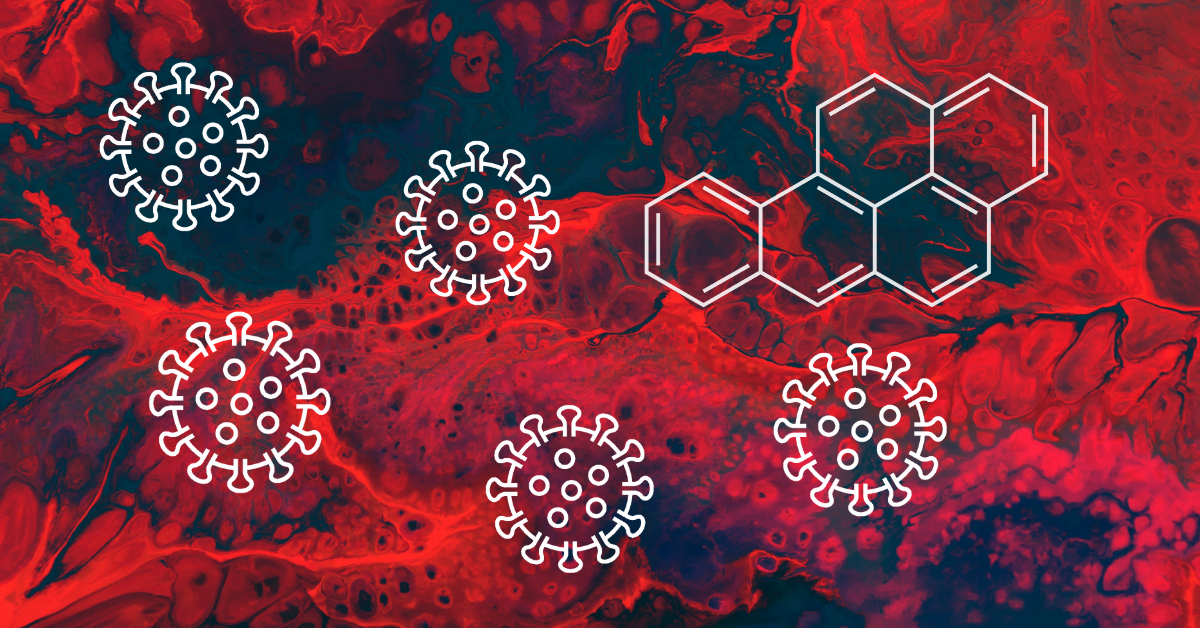Coronavirus and Thrombosis

Is coronavirus morbidity exacerbated by environmental pollution? A potential mechanism underlying thrombosis-related side effects connects multiple known risk factors.
In the early days of the COVID-19 pandemic, signs that infected patients were suffering damage to the blood vessels began to emerge. Thrombotic complications, abnormal blood clotting within the vasculature, or coagulopathies are now known to contribute to the high morbidity of this disease (Helms et al., 2020; Lowenstein et al., 2020; Matacic, 2020).
We were particularly intrigued by this finding as we had been studying why certain drug classes cause thrombosis as a side effect (Berg et al., 2015). Based on our studies, we believe that to reduce COVID-19 morbidity, it will be important to address multiple factors including the impact of environmental pollution, co-morbidities and drug exposures that contribute to thrombosis-related adverse effects.
How did our studies begin?
Polycyclic aromatic hydrocarbons (PAH) are environmental pollutants that have been linked to cardiovascular disease. PAHs naturally occur in the environment but are also produced from burning of organic matter including tobacco smoking.
In cells, PAHs are known to interact with the aryl hydrocarbon receptor (AhR), a nuclear hormone and transcription factor. Like most nuclear receptors, AhR is involved in many biological processes, often tissue specific. AhR plays a role in development as well as innate and immune responses.
Several years ago, we discovered an interesting effect of PAHs in a human primary cell-based model of endothelial cell inflammation (Kleinsteuer et al, 2014). Exposure to PAHs caused an increase the level of cell surface tissue factor(TF or CD142) on endothelial cells above the level induced by inflammation alone.
What is tissue factor (TF/CD142)?
TF is the primary cellular initiator of coagulation and thrombosis (the formation of blood clots within vessels). Our finding with TF suggests a biologically plausible hypothesis for the association of PAH exposure to cardiovascular adverse effects. Increased levels of TF on blood vessel surfaces, by causing increased thrombotic potential within the vasculature, could potentially explain the increased risk of cardiovascular events such as deep vein thrombosis (DVT), stroke and heart attacks.
Interestingly, in the earlier study (Kleinsteuer et al, 2014), a collaboration with the EPA and the ToxCast program, a similar increase in cell surface levels of tissue factor was observed with antagonists and selective modulators of the estrogen receptor (SERMs). SERMs, such as tamoxifen are used for the treatment of breast cancer and have been associated with increased risk for thrombosis-related side effects including deep vein thrombosis (Hernandez et al., 2009).
These observations led us to a deeper investigation of mechanisms that can regulate tissue factor in the endothelial cell inflammation model (BioMAP® 3C System). We were fortunate to have access to a large reference data set of 1000s of compounds tested in this system at multiple concentrations (BioMAP Reference Database, now at Eurofins Discovery). Since many of the compounds in this reference data set were target-specific, we could leverage this information to infer target mechanisms involved in regulating TF.
What mechanisms did we find?
From this analysis, we identified a number of target mechanisms beyond AhR and estrogen receptor (ER) involved in TF regulation. Interestingly, these mechanisms are involved in environmental sensing systems within the cell, including nutrient sensing (mTOR), oxygen sensing (HIF-1), lipids sensing (AhR/ER) and bacterial sensing (NOD2) systems or in lysosomal function (V-ATPase). Cellular sensing systems all share the ability to regulate lysosomal function through the process of autophagy. Autophagy is the intracellular degradation system that recycles cellular constituents as a source of energy or to remove dysfunctional proteins and organelles. Cell constituents are taken up into vacuoles and shuttled to the lysosome for degradation.
Why would autophagy in endothelial cells be connected to thrombosis?
Increased levels of TF expressed on the surface of vascular endothelial cells by triggering localized clot formation provides a mechanism to recruit nutrient rich platelets to the tissues. Platelets trapped in the clot release factors that promote angiogenesis and support wound healing. These would therefore represent beneficial responses to nutrient deprivation. If not controlled, however, normal processes can be hijacked and lead to pathologic consequences, in this case increased risk of cardiovascular events.
A connection between multiple known risk factors.
The findings from these studies provide a mechanistic connection between multiple known risk factors for thrombosis-related side effects from the environment (pollution, smoking), health co-morbidities (inflammation, infection), and drug exposure (SERMs, mTOR inhibitors, etc.).
Based on this work, as we consider the groups at greatest risk of morbidity and mortality from COVID-19, we suggest that stronger measures to mitigate these risk factors, particularly environmental pollution are warranted.
Illustration by the author using this Photo by Cassi Josh on Unsplash, the icon coronavirus by IconPai from the Noun Project and the structure of the PAH benzo[a]pyrene.






